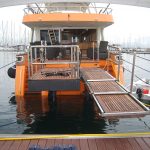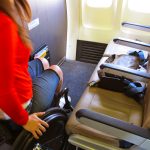An accessible RV can open a whole new world of travel and adventure for people with mobility problems. RV traveling has many advantages including an always available, clean, accessible bathroom; a comfortable bed for middle-of-the-day breaks; the opportunity to prepare and eat your own food (good if you require a special diet); a place to stay where there aren’t available hotels and an end to the hassle of carting everything from a vehicle to a hotel room. The major disadvantage is the large size of an RV. Choosing routes and parking spots requires a little more planning. Finding the right RV and equipment involves a bit of research and experimentation.
RV Types
There are four basic types of RVs – class As which look like buses, class Bs which look like fancy vans, class Cs which have a sleeping bunk over the vehicle cab, and trailers. Larger trailers, also known as fifth wheels, require a full-size pickup for towing and have steps up to the master bedroom. Since all trailers are rather complicated to hook up to the tow vehicle, I wouldn’t recommend them for someone who uses a wheelchair. Class B is usually too cramped inside with little room to maneuver a wheelchair. That leaves class As and Class Cs.
A class can be a huge luxurious home on a commercial bus chassis with a million dollar price tag or a much more modest model on a Workhorse or Ford chassis for under $100,000. Buying used saves a big chunk of money. Class As usually have a bedroom in the rear section, a living area in the front, and a kitchen in between. The cab seats swivel around to become living area seating. The floor is all on one level.
Many class C motorhomes have a queen-sized bunk over the cab but this area can also house an entertainment center. The floor plan is similar to class As but the front seat does not swivel and there is a step down to the driver and passenger seats.
Making an RV Accessible
All RVs contain everything that you need to live comfortably – a kitchen, a full bathroom, bed, dinette, furnace, air conditioner – a small but complete house. However, a typical RV presents many obstacles for a wheelchair user starting with the entry door. Entry doors are only 24”- 28” so an accessible RV will need to have a larger door installed. A standard lift can be used but I prefer a Super Arm lift because it leaves the steps in place and doorway usable for able-bodied people.
The inside can be changed and designed to be accessible with some of the same features found in houses such as roll-in showers, grab bars, adjustable beds, and ceiling tracks. Some other accessible features that might be more unique to an RV are remote control window blinds, remote control vent fans, and sofa beds that open electrically. Many of the components in RVs are scaled down which makes them easier to use from a seated position. I can easily access the entire refrigerator, the stove top, and the kitchen sink.
Buying an RV
Before buying an RV consider how you will be using it. If you plan on staying in a park for long periods of time a larger RV is probably best. You’ll also want an accessible vehicle that can be towed behind the RV. If you travel more a smaller RV without a separate towed vehicle may be a better choice.
My husband and I are full-time RVers and wanted a fairly specialized RV so we had one custom-made. It’s a small 25’ class C built on a four-wheel drive truck chassis with solar panels and large water tanks. This allows us to camp in the forest instead of relying on crowded campgrounds. To make it accessible for me and my wheelchair we had a wide entrance door and Super Arm lift installed. Our dinette seats one person. The opposite side is left open so that I can pull up to the table in my chair. We have a folding door in place of one bathroom wall and grab bars and a chair in the shower.
There are a few companies that will work with customers and make an RV that fits their needs. I recommend Winnebago if you prefer a class A and Born Free if you prefer a class C. Born Free Class C RVs are a little different than a typical C because they’re all one level and the passenger seat swivels to allow an easy transfer to and from a wheelchair. Buying new can be quite expensive but fortunately, there are used accessible RVs available. This site usually has a good selection. New listings are added often so check back if you don’t find anything suitable.
I hope to be adding more articles about accessible RV traveling. If you’d like to know more about us, our RV, and our travels please check my blog – rollinginarv-wheelchairtraveling.blogspot.com/












Thank you so much for sharing your experiences and ideas. This is such a help and much needed. I hope you will continue to posts articles as your schedule permits.
You really opened my eyes to the unique relationship folks have with their RV’s and wheelchair accessibility. I am happy to see its a possibility!
Hi: thanks for sharing your experience and knowledge. We have a 13 year old sin that is a power w/c and on a ventilator. I have been trying to find out if anyone travels for long periods or full time with a vent but have not found any info. Can I pick your brain and ask if you have ever met ventilator dependent w/c users that are living/using an rv? Thanks for listening. Nora from michigan
Nora – I don’t personally but Karen who wrote this article may very well have come across someone like this. Have you tried emailing her directly via her website?
Thank you so much for putting the website together. I have been dealing with a tumor on my spinal cord at t10/12for 18 years. The last 8 months have left me in motorized chair full time. Adjusting to the new me is emotionally and physically challenging. i still work which requires air travel which I have not attempted since losing the ability to walk.
All of this info is very helpful
We have a couple of friends friends that struggle traveling with in a wheelchair. I’ll pass this great information along to them in hopes that it can improve their experience. Thanks for sharing!
I’m interested in purchasing a wheelchair accessible Van/camper. I like to travel and don’t need anything big or luxurious. Any leads would be appreciated.
Char: Just recently I found this dealership in Orange County, CA called Aero Mobility that sells at least one kind of RV and may have access to more models. I think this model was 65K. Check it out and reach out to them: http://www.aeromobility.com/full-size-van-paratransit-product-8-wheelchair-accessible-van.html
I have always wanted to take an RV road trip across the country. I have done it a few times in cars, but hotel ‘accessibility’ is pretty hit-and-miss, as we all know, so it has always seemed preferable to me to just take what I need with me…in the form of an RV! However, not only can I not really afford to buy an RV, neither do I really want to do. I don’t need it every day or even every year. Any ideas about renting? I have searched and have found companies that come up with a Google search,… Read more »
thanks for the great information! My husband has mobility limitations (bilateral amputee and stroke survivor) and we used to love to explore the outdoors. We can’t afford an accessible RV yet, but maybe in the future. I’ve looked for accessible RV rentals in the U.S. (particularly East Coast) and I can’t find anything. Unfortunately, most RV doors are too narrow to get a wheelchair through. But if anyone else has any ideas, I’d love to hear about it. Thanks!
I like your RV! And wondered where you sleep. I would need a bed downstairs since I can’t crawl up a ladders Do they sell small RVs like the one you have?
Kim: I JUST found this site selling RVS in America. Check it out.
Hi, I live in upstate NY and was paralyzed a year and a half ago. We love to travel, but are having a hard time finding a RV/van that I can get into either with my wheelchair or from the passenger seat to a small wheelchair inside. I can not stand, so I need to be able to transfer easily. Any ideas as to where to look for used ones in NY, VT., areas? Thanks.
Hi Mary. I JUST found this site selling RVS in America. Check it out.
Mary, I see your 2014 comment. My husband could not stand or walk. He could transfer from a Jazzy chair to a special travel lift chair we installed in the doorway of our RV. Inside he used a small computer chair to move about. You may want to take a look at the motor home as I have it consigned with America Choice RV in Bushnell/Ocala Florida. It’s a 2005 Bounder. Check it out.
G’day. My partner and I are visiting the states from Australia in August. Would any be able to point us in the right direction of a company that may hire an accessible camper / motor home? We fly in the New York and will spending most of our time In Maine.
Thank you, Alison
Thanks for the info. It is inspiring as I am looking for an accessible van or RV My wife is in a power chair and she likes to sit in the passenger side in front. We like to take long trips and drive cross country. We want to travel with the grandkids. This should be an interesting journey on finding something to fit our needs.
I’m a paraplegic T12.
I’m having difficulties finding a company that rent a wheelchair accessible motorhome or RV in Europe. I’m planning to spend the summer there.
I want to rent a wheelchair accessible motorhome or RV with a hand control in Europe,
Can you help pls?
Tm
We own a Class A RV and need a wheelchair lift installed. Are you able to do that and where are you located?
Where can we rent an RV with a lift for an electric wheelchair near Pittsburgh
I am a 30 year old c6 quadriplegic. Been paralyzed for six years now. I absolutely appreciate and I am very thankful for my life. I am wondering how to rent a RV that’s has a wheelchair lift . Any direction to help me out, please let me know. Miles Anderson ♿️??
Looking for RV wheelchair accessible for end of June trip for one week?